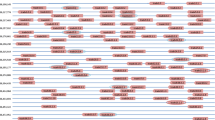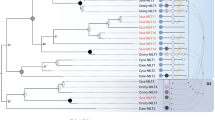Abstract
Zebrafish (Danio rerio) has become an increasingly important model for immunological study. Its immune system is remarkably similar to that of mammals and includes both the adaptive and innate branches. Zebrafish T cells express functional T cell receptors (TCR), and all four TCR loci are present within the genome. Using 5′-rapid amplification of cDNA ends, we cloned and sequenced zebrafish TCRβ transcripts. TCRβ VDJ coding joints demonstrate conservation of mechanisms used by other vertebrate species to increase junctional diversity. Using the sequences obtained, along with previously published data, we comprehensively annotated the zebrafish TCRβ locus. Overall, organization of the locus resembles that seen in mammals. There are 51 V segments, a single D segment, 27 Jβ1 segments, a single Jβ2 segment, and two constant regions. This description of the zebrafish TCRβ locus has the potential to enhance immunological research in zebrafish and further our understanding of mammalian TCR repertoire generation.



Similar content being viewed by others
References
Akamatsu Y, Tsurushita N, Nagawa F, Matsuoka M, Okazaki K, Imai M, Sakano H (1994) Essential residues in V(D)J recombination signals. J Immunol 153:4520–4529
Akira S, Okazaki K, Sakano H (1987) Two pairs of recombination signals are sufficient to cause immunoglobulin V-(D)-J joining. Science 238:1134–1138
Anderson SJ, Chou HS, Loh DY (1988) A conserved sequence in the T-cell receptor beta-chain promoter region. Proc Natl Acad Sci USA 85:3551–3554
Basu M, Hegde MV, Modak MJ (1983) Synthesis of compositionally unique DNA by terminal deoxynucleotidyl transferase. Biochem Biophys Res Commun 111:1105–1112
Crooks GE, Hon G, Chandonia JM, Brenner SE (2004) WebLogo: a sequence logo generator. Genome Res 14:1188–1190
Danilova N, Hohman VS, Sacher F, Ota T, Willett CE, Steiner LA (2004) T cells and the thymus in developing zebrafish. Dev Comp Immunol 28:755–767
DiBiase A, Harte RA, Zhou Y, Zon L, Kent WJ (2006) Piloting the zebrafish genome browser. Dev Dyn 235:747–753
Fischer C, Bouneau L, Ozouf-Costaz C, Crnogorac-Jurcevic T, Weissenbach J, Bernot A (2002) Conservation of the T-cell receptor alpha/delta linkage in the teleost fish Tetraodon nigroviridis. Genomics 79:241–248
Frazer JK, Meeker ND, Rudner L, Bradley DF, Smith AC, Demarest B, Joshi D, Locke EE, Hutchinson SA, Tripp S, Perkins SL, Trede NS (2009) Heritable T-cell malignancy models established in a zebrafish phenotypic screen. Leukemia 23:1825–1835
Haire RN, Rast JP, Litman RT, Litman GW (2000) Characterization of three isotypes of immunoglobulin light chains and T-cell antigen receptor alpha in zebrafish. Immunogenetics 51:915–923
Hedrick SM (1993) Chimeric T cell receptor-immunoglobulin molecules: function and applications. Int Rev Immunol 10:279–290
Hesse JE, Lieber MR, Mizuuchi K, Gellert M (1989) V(D)J recombination: a functional definition of the joining signals. Genes Dev 3:1053–1061
Kent WJ (2002) BLAT–the BLAST-like alignment tool. Genome Res 12:656–664
Litman GW, Anderson MK, Rast JP (1999) Evolution of antigen binding receptors. Annu Rev Immunol 17:109–147
Malissen M, McCoy C, Blanc D, Trucy J, Devaux C, Schmitt-Verhulst AM, Fitch F, Hood L, Malissen B (1986) Direct evidence for chromosomal inversion during T-cell receptor beta-gene rearrangements. Nature 319:28–33
Meeker ND, Trede NS (2008) Immunology and zebrafish: spawning new models of human disease. Dev Comp Immunol 32:745–757
Moss PA, Bell JI (1995) Sequence analysis of the human alpha beta T-cell receptor CDR3 region. Immunogenetics 42:10–18
Murray JM, O’Neill JP, Messier T, Rivers J, Walker VE, McGonagle B, Trombley L, Cowell LG, Kelsoe G, McBlane F, Finette BA (2006) V(D)J recombinase-mediated processing of coding junctions at cryptic recombination signal sequences in peripheral T cells during human development. J Immunol 177:5393–5404
Partula S, de Guerra A, Fellah JS, Charlemagne J (1995) Structure and diversity of the T cell antigen receptor beta-chain in a teleost fish. J Immunol 155:699–706
Porritt HE, Rumfelt LL, Tabrizifard S, Schmitt TM, Zuniga-Pflucker JC, Petrie HT (2004) Heterogeneity among DN1 prothymocytes reveals multiple progenitors with different capacities to generate T cell and non-T cell lineages. Immunity 20:735–745
Rast JP, Litman GW (1994) T-cell receptor gene homologs are present in the most primitive jawed vertebrates. Proc Natl Acad Sci USA 91:9248–9252
Saitou N, Nei M (1987) The neighbor-joining method: a new method for reconstructing phylogenetic trees. Mol Biol Evol 4:406–425
Schiffer M, Wu TT, Kabat EA (1986) Subgroups of variable region genes of beta chains of T-cell receptors for antigen. Proc Natl Acad Sci USA 83:4461–4463
Schorpp M, Bialecki M, Diekhoff D, Walderich B, Odenthal J, Maischein HM, Zapata AG, Boehm T (2006) Conserved functions of Ikaros in vertebrate lymphocyte development: genetic evidence for distinct larval and adult phases of T cell development and two lineages of B cells in zebrafish. J Immunol 177:2463–2476
Tillman RE, Wooley AL, Hughes MM, Khor B, Sleckman BP (2004) Regulation of T-cell receptor beta-chain gene assembly by recombination signals: the beyond 12/23 restriction. Immunol Rev 200:36–43
Traver D, Herbomel P, Patton EE, Murphey RD, Yoder JA, Litman GW, Catic A, Amemiya CT, Zon LI, Trede NS (2003) The zebrafish as a model organism to study development of the immune system. Adv Immunol 81:253–330
Varade WS, Marin E, Kittelberger AM, Insel RA (1993) Use of the most JH-proximal human Ig H chain V region gene, VH6, in the expressed immune repertoire. J Immunol 150:4985–4995
Wermenstam NE, Pilstrom L (2001) T-cell antigen receptors in Atlantic cod (Gadus morhua L.): structure, organisation and expression of TCR alpha and beta genes. Dev Comp Immunol 25:117–135
Wienholds E, Schulte-Merker S, Walderich B, Plasterk RH (2002) Target-selected inactivation of the zebrafish rag1 gene. Science 297:99–102
Willett CE, Cortes A, Zuasti A, Zapata AG (1999) Early hematopoiesis and developing lymphoid organs in the zebrafish. Dev Dyn 214:323–336
Wilson MR, Zhou H, Bengten E, Clem LW, Stuge TB, Warr GW, Miller NW (1998) T-cell receptors in channel catfish: structure and expression of TCR alpha and beta genes. Mol Immunol 35:545–557
Yazawa R, Cooper GA, Beetz-Sargent M, Robb A, McKinnel L, Davidson WS, Koop BF (2008) Functional adaptive diversity of the Atlantic salmon T-cell receptor gamma locus. Mol Immunol 45:2150–2157
Acknowledgments
NM was supported by National Institutes of Health (NIH) NICHD award 2 K12 HD001410 and an Alex’s Lemonade Stand Young Investigator award; JKF was supported by NIH NICHD award 5 K08 HD53350; JKF and NM were also supported by the Children’s Health Research Center at the University of Utah and by Primary Children’s Medical Center Foundation grants; LR was supported by NIH NIDDK T32 award DK007115; NST was supported by NIH NIAID award R21 AI079784 and the Huntsman Cancer Foundation; Huntsman Cancer Institute core facilities supported by grant P30 CA042014 also participated in this work.
Author information
Authors and Affiliations
Corresponding authors
Electronic supplementary material
Below is the link to the electronic supplementary material.
Supplemental Fig. 1
Alignment of the DJ coding joints from non-functional TCRβ cDNA transcripts. Dots indicate truncation with respect to the D or J segment used. N-nt denotes non-template nucleotide additions. J number (J#) refers to the gene identification nomenclature and is shown in bold where it occurs in more than one uniquely cloned VDJ rearrangement. Translation of highly conserved sequences is shown in the top line. The 5′-most region of each transcript is identical to genomic sequence upstream of the D cassette (GIF 83 KB)
Supplemental Fig. 2a
Zebrafish TCR Vβ segments. Alignments of 52 zebrafish TCR Vβ amino acid sequence are shown (a). Varying degrees of consensus are indicated (identical =  , block of similar =
, block of similar =  , conservative =
, conservative =  ). Consensus sequence is listed at the bottom, and proposed FR1, FR2, and FR3 boundaries are marked by gray boxes. Arrows point to highly conserved anchor residues (GIF 436 KB)
). Consensus sequence is listed at the bottom, and proposed FR1, FR2, and FR3 boundaries are marked by gray boxes. Arrows point to highly conserved anchor residues (GIF 436 KB)
Supplemental Fig. 2b
A neighbor-joining tree (b; Saitou and Nei 1987) based on a matrix of distances between all pairs of sequence was constructed with Vector NTI Advance (AlignX). Complete V segment amino acid sequences were included, and the analysis was performed using default settings (GIF 32.4 KB)
Supplemental Fig. 3
Vβ segment identity percentages. The amino acid percent identity of each Vβ pair is shown. Numbers greater than 75% are shaded (GIF 432 KB)
Supplemental Fig. S4
Zebrafish TCR Jβ segments. Alignments of 27 zebrafish TCR Jβ amino acid sequences are shown (a). Translations of Jβ cassettes are approximately 17 aa in length. Consensus regions are indicated (identical =  , block of similar =
, block of similar =  , conservative =
, conservative =  ). A neighbor-joining tree (b; Saitou and Nei 1987) demonstrates seven putative Jβ families (GIF 135 KB)
). A neighbor-joining tree (b; Saitou and Nei 1987) demonstrates seven putative Jβ families (GIF 135 KB)
Supplemental Fig. 5
Jβ segment identity percentages. The amino acid percent identity of each Jβ pair is shown (GIF 153 KB)
Supplemental Table 1
Primer sequences (DOC 56 kb)
Supplementary Material
TCR beta locus annotation (TXT 385 KB)
Rights and permissions
About this article
Cite this article
Meeker, N.D., Smith, A.C.H., Frazer, J.K. et al. Characterization of the zebrafish T cell receptor β locus. Immunogenetics 62, 23–29 (2010). https://doi.org/10.1007/s00251-009-0407-6
Received:
Accepted:
Published:
Issue Date:
DOI: https://doi.org/10.1007/s00251-009-0407-6




